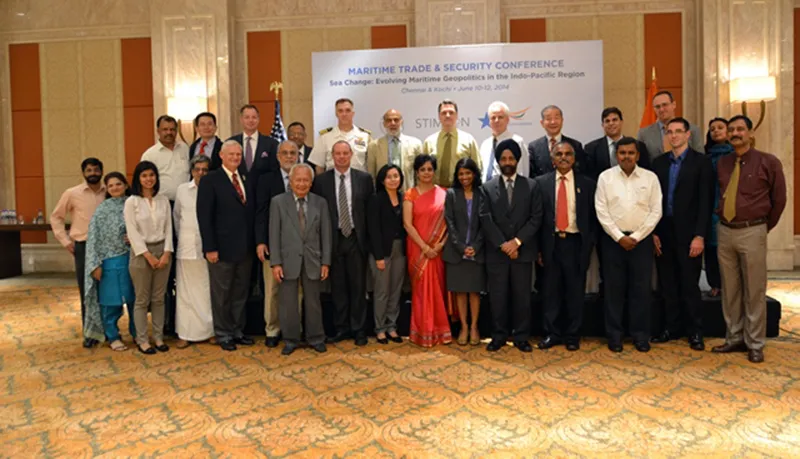A four-day maritime conference on "Maritime Geo-Politics in the Indo-pacific" was organised in Chennai, Kochi and New Delhi recently. The conference saw speakers deliver perspectives from India, China, Japan, US, Australia and Indonesia.

A four-day maritime conference to discuss the growing importance of the Indo-Pacific region in maritime security was organised by Observer Research Foundation and the Stimson Centre, US, in association with the U.S. Consulate General, Chennai. Held in three parts, the conference kicked off in Chennai (10-11 June, 2014) before moving on to Kochi (12 June) and finally ending at New Delhi (13 June).
The conference saw speakers deliver perspectives from India, China, Japan, United States, Australia and Indonesia on the "Maritime Geo-Politics in the Indo-pacific". The sessions also explored security issues such as piracy and safety of sea lanes, natural resources and environmental challenges, climate change and the law of the sea. The conference saw the participation of some of the leading maritime security experts in India and through the Indo-Pacific.
During the inaugural session, Inspector General of the Indian Coast Guard (East), S.P. Sharma, outlined the Indian perspective and the growing use of the term Indo-Pacific. Reflecting on the Indian views, he drew on the rich maritime history of the region connecting India with almost every sub-continent of the Indo-Pacific through trade links. He remarked that India continues to believe in the central role ASEAN and the Southeast Asian nations play in the region and that the India-ASEAN relationship is a strategic priority in India’s ’Look East Policy’. Talking about India’s strategy in the region, he noted that freedom of navigation and rightful use of the ’global commons’ are fundamental for the common good of the region. Upholding the principles of freedom of navigation and ’unimpeded lawful commerce’ figures prominently in India’s strategy in the region.
The perspective from China outlined the recent development of the term ’Indo-Pacific’ within Chinese scholars soon after former Secretary of State, Hilary Clinton mentioned it in a speech in 2010. It was pointed out that for Chinese scholars; the term also indicates the extension of Chinese and the Indian Navy’s foray into each other’s strategic spaces resulting in the increase of their strategic competition. Chinese sentiments reflected the increasing use of the terms ’Indo-Pacific’ and ’Asia-pacific’ interchangeably by the Americans to establish alliances in the region in order to balance the rise of China.
The American perspective repeatedly emphasised on the need to assure freedom of navigation through these waters and ’free movement of trade and access to resources’. This was discussed in the background of the importance of the ’Malacca Strait’ chokepoint, which carries 1/3 rd of the world trade and over $1.2 trillion in U.S. trade. The focal point of the US perspective in the Indo-Pacific was maritime security entailing the right to freedom of navigation through important waters lacing the Indo-Pacific. The American maritime strategy was outlined in the form of maritime partnerships and bi-lateral and multilateral exercises in order to engage and cooperate with most maritime nations in the Indo-pacific region.
The Indonesian perspective reflected on the geographic definition of the term Indo-Pacific- a triangular area between Japan in the north, Australia in the Southeast and India in the Southwest. It was also noted that according to this triangle, ASEAN and Southeast Asia lies right at the heart of the Indo-Pacific. It was also underlined that the Indo-Pacific however is more of a strategic construct and less of a geographic expression, although the ’centrality’ of ASEAN in the development and implementation of the concept remains un-contested. It was noted that for Indonesia, it remains critical to be not ’sandwiched’ by the conflicting interests and the display of power play by US, Japan, Australia and possibly India -- to carefully balance a rising China. Indonesia’s perception of India is that New Delhi has developed its ’Look East Policy’ to ’Act East Policy’ and ’Engage East policy’ indicating an increased interest in the region. Finally, it was laid out that Indonesia should and could support the idea of Indo-Pacific to promote peace, stability and cooperation in the region.
The Japanese perspective was delivered with an overview of the increasing Chinese maritime capabilities in the region and Beijing’s unilateral actions to change the status quo by force both at sea and air. According to the Japanese perspective, China’s maritime policy in the region lies in Anti-Access/Area Denial (A2/AD) capabilities. For Japan, the core of the issue right now is to assure a risk free region and to assure freedom of navigation through the East China Sea and the South China Sea. It was pointed out that countries must come together to govern the important Sea Lanes of Communications (SLOC) by international law to ensure stable seas. It was put forth that any new security architecture in the region should be based on rule of law, no use of force and peaceful settlement of disputes and Japan will spare no effort to make the region stable, peaceful and prosperous.
The conference then debated and discussed in length the issues surrounding security challenges in the Indo-Pacific, security structures, trade and maritime highway, environmental challenges and International order in the Indo-pacific. The discussions were attended by senior officers and policy makers, academia, business leaders, analysts, military officials, and experts from the energy and the shipping industry from countries throughout the Indo-Pacific region.
A compilation of all the conference presentations can be found here
(This report is prepared by Darshana M. Baruah, Junior Fellow, Observer Research Foundation, Delhi)
The views expressed above belong to the author(s). ORF research and analyses now available on Telegram! Click here to access our curated content — blogs, longforms and interviews.




 PREV
PREV

